Abstract
Steady-state mathematical models are developed according to which adenosine is formed in the cytoplasm of a group of cells, arises in the extracellular space via the symmetric nucleoside transporter and is inactivated in the adenosine forming cells and after rate-limiting transport into other cell-types. Dipyridamole increases the Km and Vmax. of the transporter symmetrically with respect to influx and efflux. Models incorporating differing degrees of compartmentation are used to predict intracellular and extracellular adenosine concentration as a function of dipyridamole concentration and adenosine formation rate. The vasodilator action of dipyridamole is explained since it is predicted to elevate interstitial fluid adenosine concentrations at all rates of adenosine formation provided that washout of the interstitial compartment is restricted.
Full text
PDF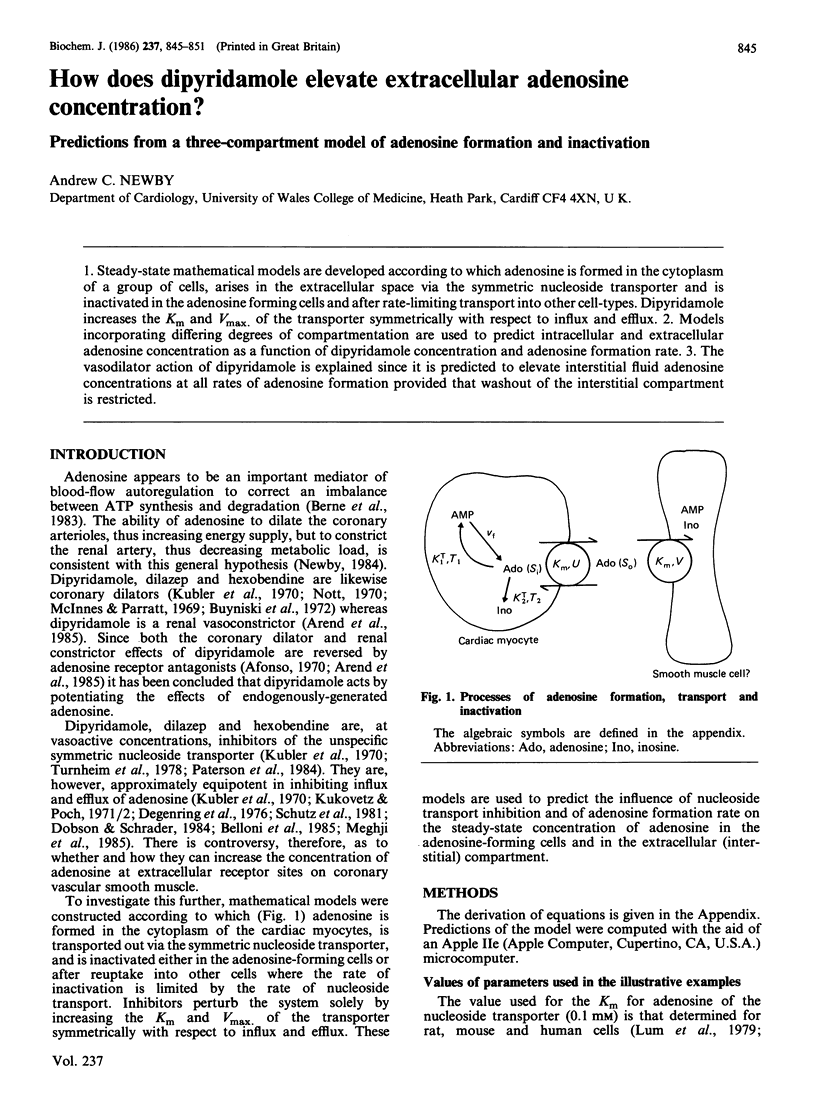
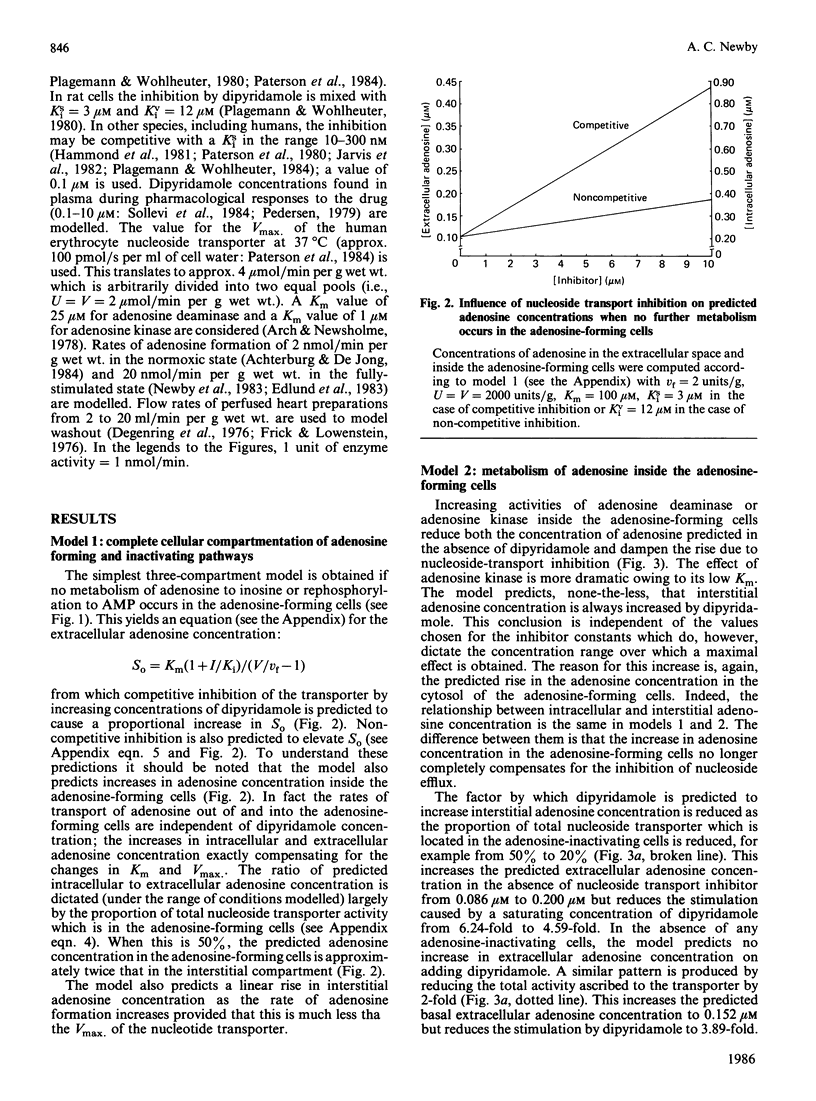
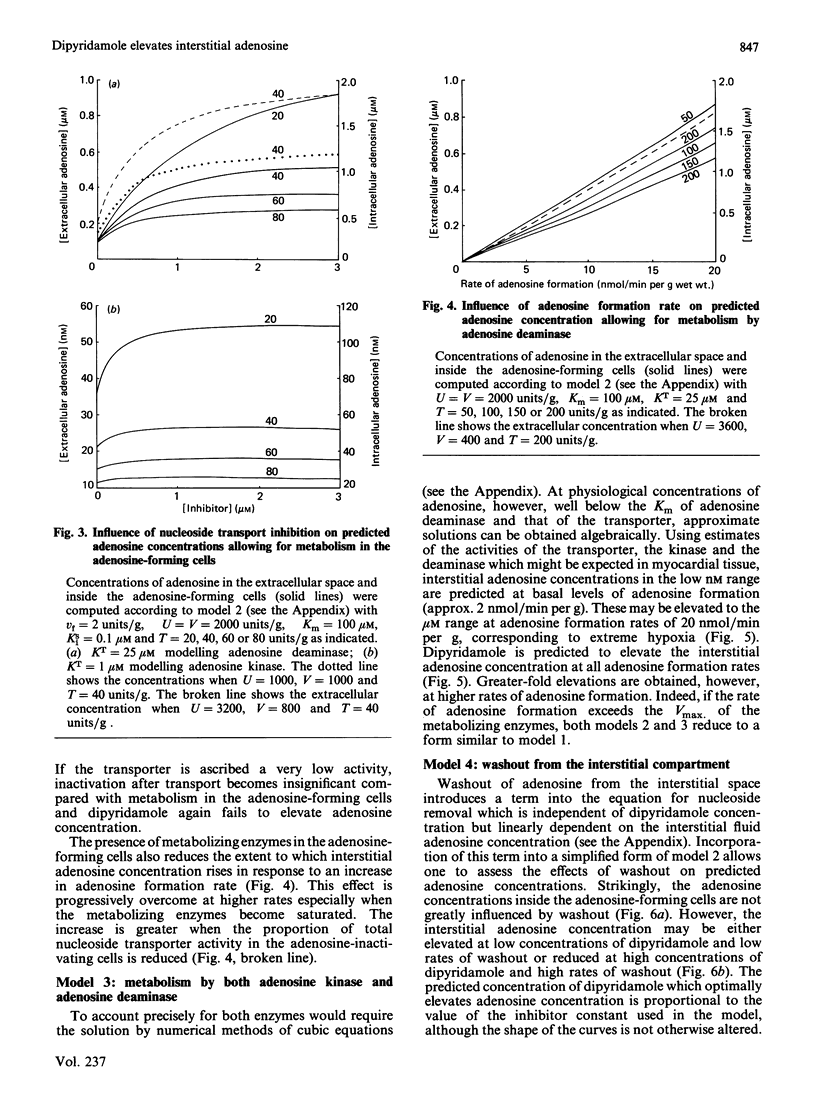
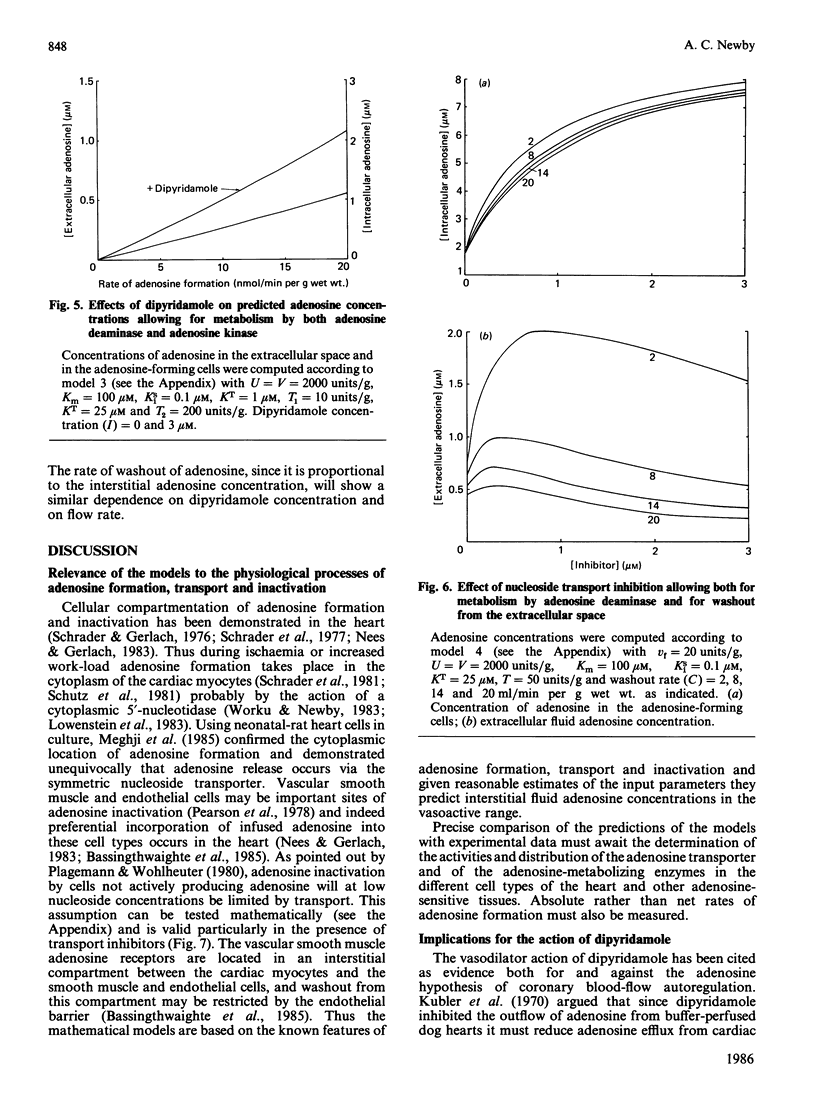
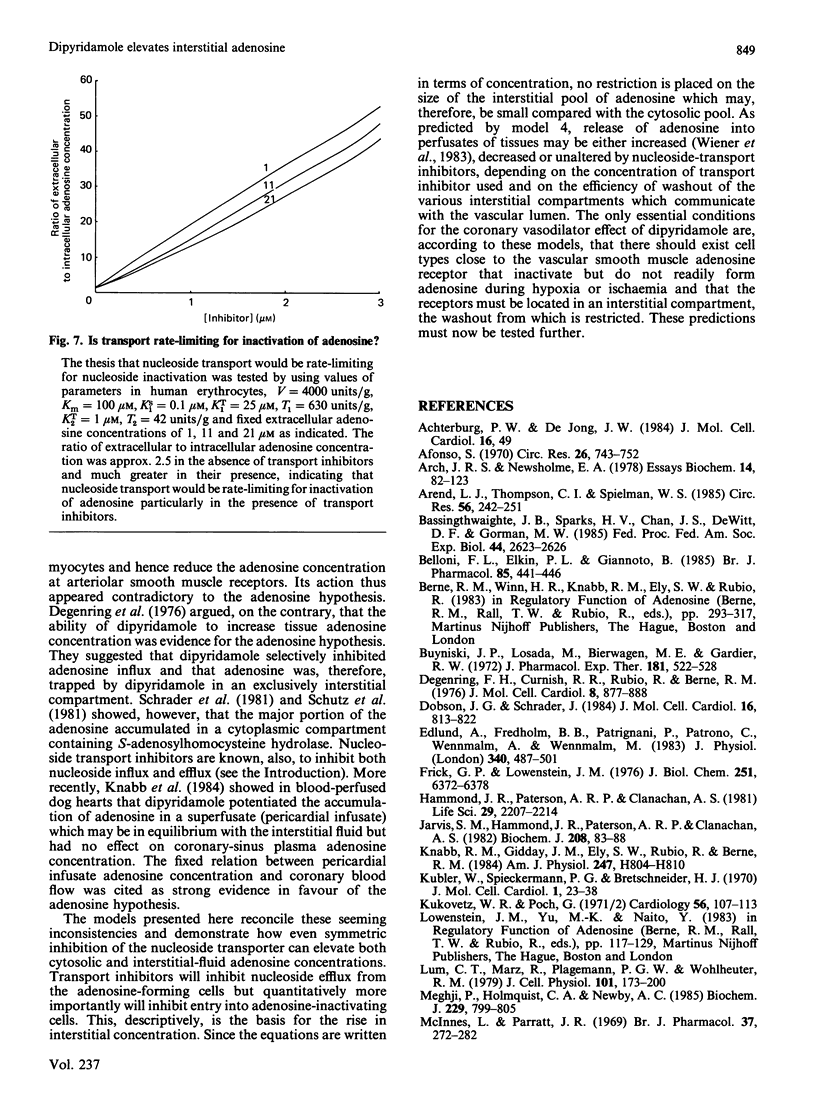
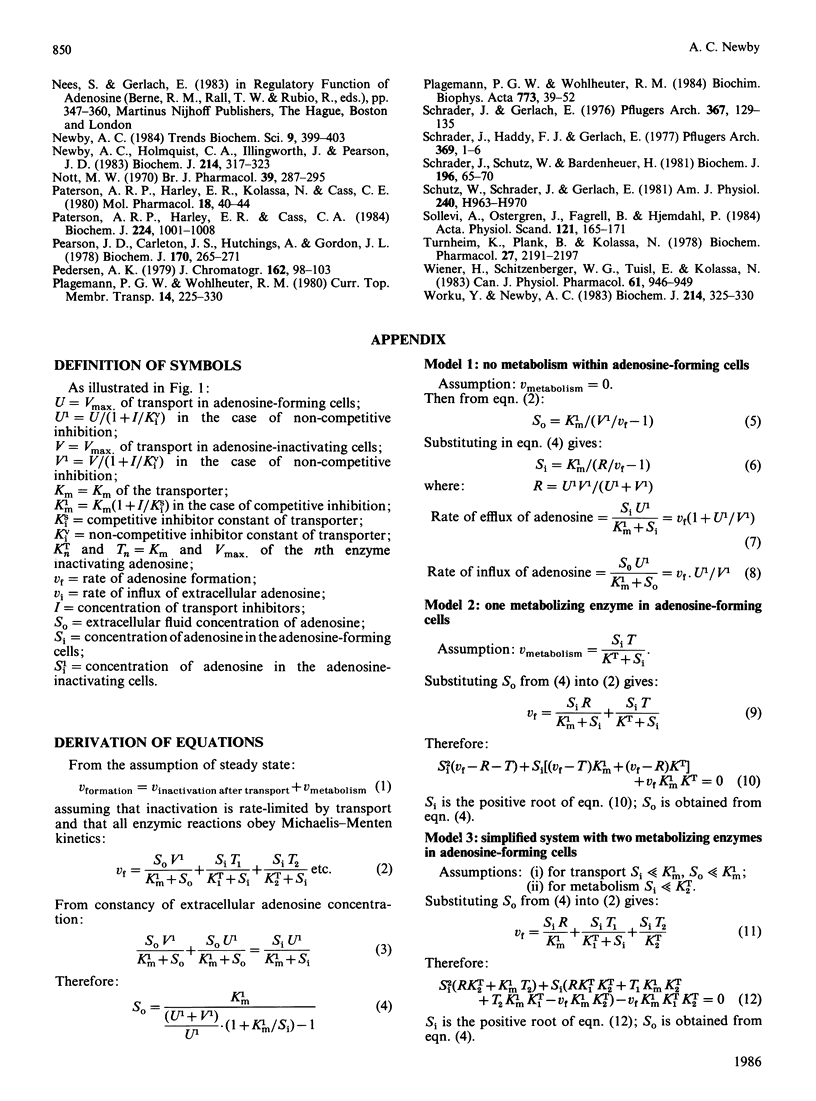
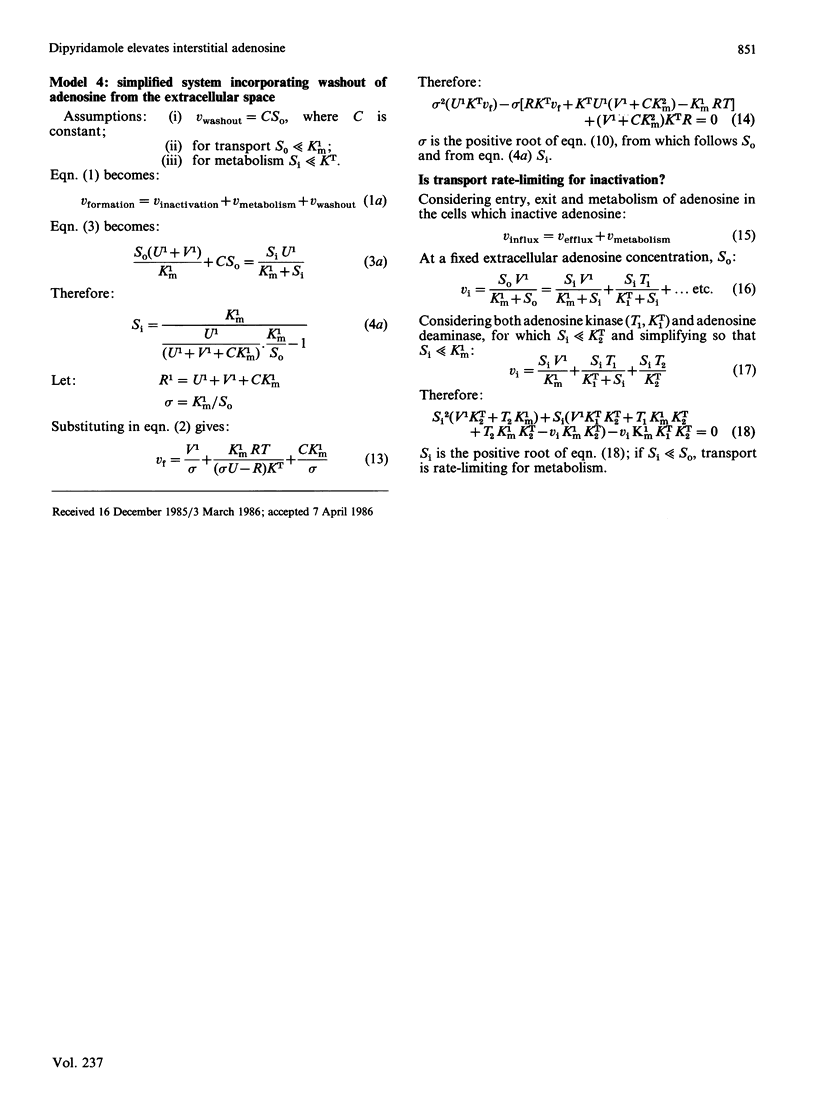
Selected References
These references are in PubMed. This may not be the complete list of references from this article.
- Afonso S. Inhibition of coronary vasodilating action of dipyridamole and adenosine by aminophylline in the dog. Circ Res. 1970 Jun;26(6):743–752. doi: 10.1161/01.res.26.6.743. [DOI] [PubMed] [Google Scholar]
- Arch J. R., Newsholme E. A. The control of the metabolism and the hormonal role of adenosine. Essays Biochem. 1978;14:82–123. [PubMed] [Google Scholar]
- Arend L. J., Thompson C. I., Spielman W. S. Dipyridamole decreases glomerular filtration in the sodium-depleted dog. Evidence for mediation by intrarenal adenosine. Circ Res. 1985 Feb;56(2):242–251. doi: 10.1161/01.res.56.2.242. [DOI] [PubMed] [Google Scholar]
- Bassingthwaighte J. B., Sparks H. V., Jr, Chan I. S., DeWitt D. F., Gorman M. W. Modeling of transendothelial transport. Fed Proc. 1985 Jul;44(10):2623–2626. [PMC free article] [PubMed] [Google Scholar]
- Belloni F. L., Elkin P. L., Giannotto B. The mechanism of adenosine release from hypoxic rat liver cells. Br J Pharmacol. 1985 Jun;85(2):441–446. doi: 10.1111/j.1476-5381.1985.tb08880.x. [DOI] [PMC free article] [PubMed] [Google Scholar]
- Buyniski J. P., Losada M., Bierwagen M. E., Gardier R. W. Cerebral and coronary vascular effects of a symmetrical N,N'-disubstituted hexahydrodiazepine. J Pharmacol Exp Ther. 1972 Jun;181(3):522–528. [PubMed] [Google Scholar]
- Degenring F. H., Curnish R. R., Rubio R., Berne R. M. Effect of dipyridamole on myocardial adenosine metabolism and coronary flow in hypoxia and reactive hyperemia in the isolated perfused guinea pig heart. J Mol Cell Cardiol. 1976 Nov;8(11):877–888. doi: 10.1016/0022-2828(76)90070-5. [DOI] [PubMed] [Google Scholar]
- Dobson J. G., Jr, Schrader J. Role of extracellular and intracellular adenosine in the attenuation of catecholamine evoked responses in guinea pig heart. J Mol Cell Cardiol. 1984 Sep;16(9):813–822. doi: 10.1016/s0022-2828(84)80005-x. [DOI] [PubMed] [Google Scholar]
- Edlund A., Fredholm B. B., Patrignani P., Patrono C., Wennmalm A., Wennmalm M. Release of two vasodilators, adenosine and prostacyclin, from isolated rabbit hearts during controlled hypoxia. J Physiol. 1983 Jul;340:487–501. doi: 10.1113/jphysiol.1983.sp014775. [DOI] [PMC free article] [PubMed] [Google Scholar]
- Frick G. P., Lowenstein J. M. Studies of 5'-nucleotidase in the perfused rat heart. Including measurements of the enzyme in perfused skeletal muscle and liver. J Biol Chem. 1976 Oct 25;251(20):6372–6378. [PubMed] [Google Scholar]
- Hammond J. R., Paterson A. R., Clanachan A. S. Benzodiazepine inhibition of site-specific binding of nitrobenzylthioinosine, an inhibitor of adenosine transport. Life Sci. 1981 Nov 23;29(21):2207–2214. doi: 10.1016/0024-3205(81)90492-6. [DOI] [PubMed] [Google Scholar]
- Jarvis S. M., Hammond J. R., Paterson A. R., Clanachan A. S. Species differences in nucleoside transport. A study of uridine transport and nitrobenzylthioinosine binding by mammalian erythrocytes. Biochem J. 1982 Oct 15;208(1):83–88. doi: 10.1042/bj2080083. [DOI] [PMC free article] [PubMed] [Google Scholar]
- Knabb R. M., Gidday J. M., Ely S. W., Rubio R., Berne R. M. Effects of dipyridamole on myocardial adenosine and active hyperemia. Am J Physiol. 1984 Nov;247(5 Pt 2):H804–H810. doi: 10.1152/ajpheart.1984.247.5.H804. [DOI] [PubMed] [Google Scholar]
- Kukovetz W. R., Pöch G. Inhibition of hypoxia-induced rise in adenosine release and flow by coronary dilators. Cardiology. 1971;56(1):107–113. doi: 10.1159/000169350. [DOI] [PubMed] [Google Scholar]
- Kübler W., Spieckermann P. G., Bretschneider H. J. Influence of dipyridamol (Persantin) on myocardial adenosine metabolism. J Mol Cell Cardiol. 1970 Mar;1(1):23–38. doi: 10.1016/0022-2828(70)90026-x. [DOI] [PubMed] [Google Scholar]
- Lum C. T., Marz R., Plagemann P. G., Wohlhueter R. M. Adenosine transport and metabolism in mouse leukemia cells and in canine thymocytes and peripheral blood leukocytes. J Cell Physiol. 1979 Nov;101(2):173–200. doi: 10.1002/jcp.1041010202. [DOI] [PubMed] [Google Scholar]
- McInnes L., Parratt J. R. Studies on the mode of action of hexobendine, a prospective anti-anginal drug. Br J Pharmacol. 1969 Sep;37(1):272–282. doi: 10.1111/j.1476-5381.1969.tb09544.x. [DOI] [PMC free article] [PubMed] [Google Scholar]
- Meghji P., Holmquist C. A., Newby A. C. Adenosine formation and release from neonatal-rat heart cells in culture. Biochem J. 1985 Aug 1;229(3):799–805. doi: 10.1042/bj2290799. [DOI] [PMC free article] [PubMed] [Google Scholar]
- Newby A. C., Holmquist C. A., Illingworth J., Pearson J. D. The control of adenosine concentration in polymorphonuclear leucocytes, cultured heart cells and isolated perfused heart from the rat. Biochem J. 1983 Aug 15;214(2):317–323. doi: 10.1042/bj2140317. [DOI] [PMC free article] [PubMed] [Google Scholar]
- Nott M. W. The possible role of adenosine in the coronary dilator action of some pyrimidopyrimidines and pteridines. Br J Pharmacol. 1970 Jun;39(2):287–295. doi: 10.1111/j.1476-5381.1970.tb12892.x. [DOI] [PMC free article] [PubMed] [Google Scholar]
- Paterson A. R., Harley E. R., Cass C. E. Inward fluxes of adenosine in erythrocytes and cultured cells measured by a quenched-flow method. Biochem J. 1984 Dec 15;224(3):1001–1008. doi: 10.1042/bj2241001. [DOI] [PMC free article] [PubMed] [Google Scholar]
- Paterson A. R., Lau E. Y., Dahlig E., Cass C. E. A common basis for inhibition of nucleoside transport by dipyridamole and nitrobenzylthioinosine? Mol Pharmacol. 1980 Jul;18(1):40–44. [PubMed] [Google Scholar]
- Pearson J. D., Carleton J. S., Hutchings A., Gordon J. L. Uptake and metabolism of adenosine by pig aortic endothelial and smooth-muscle cells in culture. Biochem J. 1978 Feb 15;170(2):265–271. doi: 10.1042/bj1700265. [DOI] [PMC free article] [PubMed] [Google Scholar]
- Pedersen A. K. Specific determination of dipyridamole in serum by high-performance liquid chromatography. J Chromatogr. 1979 Jan 1;162(1):98–103. doi: 10.1016/s0378-4347(00)82069-1. [DOI] [PubMed] [Google Scholar]
- Plagemann P. G., Wohlhueter R. M. Nucleoside transport in cultured mammalian cells. Multiple forms with different sensitivity to inhibition by nitrobenzylthioinosine or hypoxanthine. Biochim Biophys Acta. 1984 Jun 13;773(1):39–52. doi: 10.1016/0005-2736(84)90548-0. [DOI] [PubMed] [Google Scholar]
- Schrader J., Gerlach E. Compartmentation of cardiac adenine nucleotides and formation of adenosine. Pflugers Arch. 1976 Dec 28;367(2):129–135. doi: 10.1007/BF00585148. [DOI] [PubMed] [Google Scholar]
- Schrader J., Schütz W., Bardenheuer H. Role of S-adenosylhomocysteine hydrolase in adenosine metabolism in mammalian heart. Biochem J. 1981 Apr 15;196(1):65–70. doi: 10.1042/bj1960065. [DOI] [PMC free article] [PubMed] [Google Scholar]
- Schütz W., Schrader J., Gerlach E. Different sites of adenosine formation in the heart. Am J Physiol. 1981 Jun;240(6):H963–H970. doi: 10.1152/ajpheart.1981.240.6.H963. [DOI] [PubMed] [Google Scholar]
- Sollevi A., Ostergren J., Fagrell B., Hjemdahl P. Theophylline antagonizes cardiovascular responses to dipyridamole in man without affecting increases in plasma adenosine. Acta Physiol Scand. 1984 Jun;121(2):165–171. doi: 10.1111/j.1748-1716.1984.tb07443.x. [DOI] [PubMed] [Google Scholar]
- Turnheim K., Plank B., Kolassa N. Inhibition of adenosine uptake in human erythrocytes by adenosine-5'-carboxamides, xylosyladenine, dipyridamole, hexobendine, and p-nitrobenzylthioguanosine. Biochem Pharmacol. 1978;27(18):2191–2197. doi: 10.1016/0006-2952(78)90076-x. [DOI] [PubMed] [Google Scholar]
- Wiener H., Schützenberger W. G., Tuisl E., Kolassa N. Theoretical analysis of adenosine release from cardiac tissue as influenced by transport inhibitors. Can J Physiol Pharmacol. 1983 Aug;61(8):946–949. doi: 10.1139/y83-141. [DOI] [PubMed] [Google Scholar]
- Worku Y., Newby A. C. The mechanism of adenosine production in rat polymorphonuclear leucocytes. Biochem J. 1983 Aug 15;214(2):325–330. doi: 10.1042/bj2140325. [DOI] [PMC free article] [PubMed] [Google Scholar]


